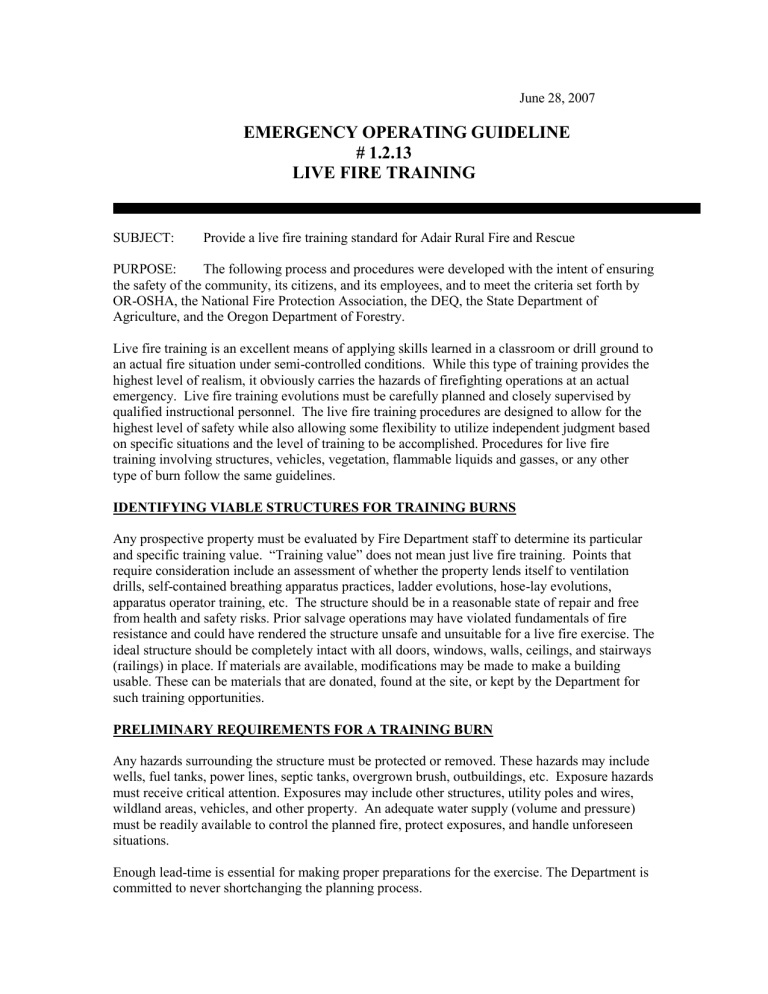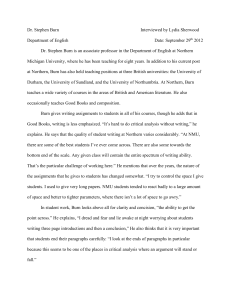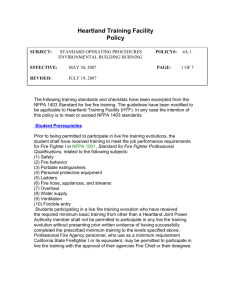April 21, 1991 - Adair Rural Fire & Rescue

June 28, 2007
EMERGENCY OPERATING GUIDELINE
# 1.2.13
LIVE FIRE TRAINING
SUBJECT: Provide a live fire training standard for Adair Rural Fire and Rescue
PURPOSE: The following process and procedures were developed with the intent of ensuring the safety of the community, its citizens, and its employees, and to meet the criteria set forth by
OR-OSHA, the National Fire Protection Association, the DEQ, the State Department of
Agriculture, and the Oregon Department of Forestry.
Live fire training is an excellent means of applying skills learned in a classroom or drill ground to an actual fire situation under semi-controlled conditions. While this type of training provides the highest level of realism, it obviously carries the hazards of firefighting operations at an actual emergency. Live fire training evolutions must be carefully planned and closely supervised by qualified instructional personnel. The live fire training procedures are designed to allow for the highest level of safety while also allowing some flexibility to utilize independent judgment based on specific situations and the level of training to be accomplished. Procedures for live fire training involving structures, vehicles, vegetation, flammable liquids and gasses, or any other type of burn follow the same guidelines.
IDENTIFYING VIABLE STRUCTURES FOR TRAINING BURNS
Any prospective property must be evaluated by Fire Department staff to determine its particular and specific training value. “Training value” does not mean just live fire training. Points that require consideration include an assessment of whether the property lends itself to ventilation drills, self-contained breathing apparatus practices, ladder evolutions, hose-lay evolutions, apparatus operator training, etc. The structure should be in a reasonable state of repair and free from health and safety risks. Prior salvage operations may have violated fundamentals of fire resistance and could have rendered the structure unsafe and unsuitable for a live fire exercise. The ideal structure should be completely intact with all doors, windows, walls, ceilings, and stairways
(railings) in place. If materials are available, modifications may be made to make a building usable. These can be materials that are donated, found at the site, or kept by the Department for such training opportunities.
PRELIMINARY REQUIREMENTS FOR A TRAINING BURN
Any hazards surrounding the structure must be protected or removed. These hazards may include wells, fuel tanks, power lines, septic tanks, overgrown brush, outbuildings, etc. Exposure hazards must receive critical attention. Exposures may include other structures, utility poles and wires, wildland areas, vehicles, and other property. An adequate water supply (volume and pressure) must be readily available to control the planned fire, protect exposures, and handle unforeseen situations.
Enough lead-time is essential for making proper preparations for the exercise. The Department is committed to never shortchanging the planning process.
EOG1.2.13
Page 2
If a structure meets the preliminary requirements, the owner (or his/her legal representative) must be willing to arrange for, and provide documentation of, the following:
Clear proof of ownership and evidence of clear title must be provided, along with a signed and notarized property burn release (copy attached). Please note that Fire Department
Administration personnel will not be available to notarize this documentation. It is the responsibility of the property owner to arrange for notarization on his/her own.
A copy of a DEQ-approved inspector’s survey, showing no asbestos present.
Acquisition of a demolition permit in the City or the County.
If on a sewer service, acquisition of a sewer disconnect permit and certification of work completed.
Cancellation of all fire insurance on the building.
Disconnection of all utilities.
Removal of any personal items that are not to be burned.
Removal of any and all water tanks, fuel tanks, explosives, aerosols, closed containers, etc.
The documentation cited above becomes a permanent record of the Adair Rural Fire Rescue.
The property owner must also assure full responsibility for safety at the site immediately after the
Adair Rural Fire completes the training burn and returns the property to said owner. The owner is also made aware that if the structure cannot be burned, or is partially burned (due to a change in weather condition or receipt of an emergency alarm), s/he will assume responsibility for the structure immediately upon the Adair Rural Fire’s departure. The property owner shall be responsible for clean up any and all debris remaining at the “burn” site.
PROPERTY INSPECTION
After the owner has completed his/her responsibilities, Staff willconfirm that the structure is ready. Items checked are:
1.
Confirm that utilities are disconnected.
2.
Structure intact (doors, windows, ceilings, etc.).
3.
All agreed-upon salvaged items removed.
4.
Hazardous devices removed (water heaters, fuel tanks, etc.)
5.
Suspected asbestos-containing materials are abated or determined by qualified individuals to be asbestos free.
6.
Site plan for the proposed drill.
The owner will be provided a copy of letter explaining what items were to be salvaged, any exposures (trees, shrubs, etc.) that may be destroyed during the exercise, and outlining responsibilities for cleaning up the site (attached).
NOTIFICATIONS TO BE MADE BY THE FIRE DEPARTMENT
When planning a live-fire training exercise the Departmental staff will notify any agency, citizen, and/or news media directly or remotely associated with the training.
1. Will be Notified:
EOG 1.2.13
Page 3
Adjacent neighbors:- Industrial, commercial, residential
City Manager
Public Safety Dispatch Center (Benton 911)
2. May be Notified:
Hospitals
Neighborhood associations
Public Works (to consult about water levels, request authority to block off roads)
Law Enforcement - (local, county, or State Police) to- request assistance in traffic control if needed
Department of Environmental Quality (even though there is an exemption to perform live fire training exercises, they prefer to be notified when an exercise is to occur)
Mutual Aid Fire Districts ( invite them to the training)
Nearby schools or institutions (if in session at the time of the burn)
News media
Others
The following information is provided:
Nature of the activity
Reason for the activity (the value of the specific training)
Location of the activity
Schedule of the activity
How the training is going to be conducted
Departmental persons to contact for information (typically, the Training Division personnel and the Fire Chief)
In addition to the above, when possible, at least seven days prior to the live fire exercise, the department will distribute flyers in the neighborhood surrounding the proposed burn. Whenever possible, staff will meet face-to-face with neighbors and business owners as appropriate to discuss training objectives, anticipated effects in the area, and to give the citizens the names and phone numbers of the Fire Department representatives.
As contacts are made, the name of individual / agency, the telephone number, the person contacted, and his/her reactions are logged.
PLANNING AND DIRECTION
All live fire training shall be conducted under the direction and approval of the Officer or his/her designee after ensuring that all information and signed forms have been received from the property owner.
A qualified Safety Officer shall be appointed to prevent/eliminate unsafe acts during live fire training. The Safety Officer shall have the authority to intervene and control any aspect of the operation when an unsafe or potentially unsafe condition exists.
A qualified instructor shall be assigned to each functional crew, which shall not exceed five
EOG 1.2.13
Page 4 students. Prior to participation in live fire training, students shall have completed training as prescribed in DPSST “Entry Level Firefighter" NFPA 1403 or equivalent.
Prior to conducting live fire training evolutions, a pre-burn briefing session shall be conducted for all participants. All evolutions to be conducted shall be discussed and assignments made for crews participating in the training.
All spectators shall be restricted to an area outside an operations area perimeter established by the
Safety Officer.
An Incident Command System and a sufficient number of radios shall be employed to assure effective communication and control of the training operation.
SPECIFIC PLANS RELATED TO STRUCTURE BURNS
An essential element of planning is creating an Incident Action Plan (IAP). An IAP is the written plan describing the objective of the drill and how it will be conducted, safety plan, medical plans for injuries, as well as any other item pertinent to the exercise. This document is used for the initial briefing and becomes a part of the final burn file to be kept by the Department. The actual plans are quite detailed. For the purpose of an overview, essential plan elements would include:
-
-
-
-
Water supply
- Two sources of water and two sources of pressure
Water supply is broken into two stages:
Adequate fire flow for attack, exposure protection, and other contingencies
Adequate total volume available to conduct the total exercise
A plan for the specific type/s of structure fire training exercises to be conducted
-Divisions and groups
-Operations
-Exterior fire attack
-Weather conditions
-Temperature
-Humidity
-Wind direction and velocity
Adequate apparatus-of type and design to conduct the training burn.
PRE-BURN SAFETY BRIEFING
Prior to conducting actual live fire training evolutions a briefing of the site plan and IAP will be conducted a) b)
The chain of command (to include responsibilities of each officer).
All evolutions to be conducted and assignments made for all crews participating c) in the exercise.
Specific training objectives as well as the specific aspects of participant responsibilities. d) Prior to conducting any live fire training, all personnel will tour the site to gain knowledge and familiarity with the layout in order to facilitate necessary emergency evacuations.
EOG 1.2.13
Page 5 e) All personnel must be informed of the evacuation procedures, evacuation signal, hazards, and the risks involved. f) g) h)
All personnel must report to accountability or safety officers before entry and after exiting on every evolution.
All injuries (no matter how small) are to be reported to safety officer.
All personnel are to take breaks as required for rehab to prevent dehydration and i) exhaustion.
All personnel are to remain in Staging or Rehab area unless assigned. No one is allowed to wander around the training site unless instructed.
VEHICLE BURNS
Vehicles brought to the Drill Facility can be used for live fire training. Any vehicles used for rescue and extrication training can be used in live fire instruction. An added advantage is that the vehicle can still be used for instruction with rescue tools after burning. Certain steps and precautions are followed in obtaining and setting up vehicles for burning: a) b)
Obtain a signed release from donor.
Ensure the party donating has clear title. c) d) e) containers) f) g) h) i)
Ensure no insurance is carried on the vehicle.
Set up vehicle away from exposures and power lines.
Check for hazards inside (aerosols, oil, gas, shock absorbers, and other
Set up safety zone around the site.
Remove fuel from tank.
Avoid burning tires.
Participating personnel are in full personal protective equipment with selfj) k) contained breathing apparatus.
No attack or backup lines smaller than 1-1/2” line.
Incident Action Plan completed.
The drill follows the structural process with regard to water supply. Adequate water supply must a) b) c) d) e) f) be used for the size of vehicle, and a backup line from a second water source must be provided.
VEGETATION BURNS
There are often opportunities to train firefighters using vegetation. Many of these opportunities involve collaboration with other departments or agencies. Vegetation burns often provide the added benefit of weed abatement/removal and restoration of park environments. Precautions to follow and elements include:
Definition of area to be burned.
Reduction of hazards in the area (snag trees, non vegetative debris, etc.).
Identification of hazards in the area (ditches, holes, etc.).
Establishment of a containment line around burn area.
Development of an escape plan.
Provision of adequate resources for overall containment. g) h)
Provision of adequate water supply to maintain water at site while fire is burning.
Creation of Incident Action Plan.
EOG 1.2.13
Page 6
Burning must not occur if smoke will be carried over roadways and create a visibility hazard.
FLAMMABLE LIQUID AND GAS (FLAG) TRAINING c) d) e)
DPSST will provide us with flammable liquids training. Requirements for this training include: a) Completion of the class room portion of the DPSST program. b) b)
A training area that is clear of obstructions.
Adequate allowance for hose line movement.
All personnel in full personal protective equipment and breathing apparatus.
Incident Action Plan completed.
Instructors to oversee all operations and ensure proper fog patterns on nozzles.
PROTECTIVE CLOTHING AND EQUIPMENT
Each participant in live fire training shall be equipped with full protective clothing meeting the current NFPA standard. Protective clothing shall be properly worn during the training exercise.
Participants expected to enter hazardous atmospheres shall be equipped with SCBA. Wildland training requires the appropriate PPE also and structural PPE should only be used with caution, overheating and limited mobility being considerations.
WATER SUPPLY
Water supply requirements shall meet OR-OSHA standards as set forth in OAR 437-002-0182.
The instructor in charge of the live fire training evolutions shall determine, prior to each specific evolution, how many training attack lines and backup lines will be necessary. Sufficient backup lines shall be provided to ensure adequate protection for personnel on training attack lines.
Sufficient personnel and one instructor shall be assigned to each backup line.
The water supply for live fire training shall be a total sustained water supply in gallons as calculated utilizing the Iowa formula. The required water supply shall be increased by 25 percent for each side of the structure which has an exposure under 50 feet away.
Any time the total available water supply drops below 50 percent of the required available supply all interior fire fighting operations shall cease.
Separate sources shall be utilized for supply of attack lines and backup lines additional water in the amount of 50 percent of the anticipated fire flow for a period of 5 minutes shall be available for exposure protection and potential contingencies in order to preclude the loss of both water supply sources at the same time.
________________________
Chuck Harris, Fire Chief
INITIAL SITE SURVEY
Structure Address:
Owner’s Name:
Owner’s Phone #1:
Owner’s Address:
Structure Information
Type:
No. of Stories:
Basement:
General Description:
Date of Initial Contact:
Referred by:
Owner’s Phone #2:
No. of Rooms:
Approx. Sq. Ft.:
Enclosed Attic:
Hazardous Conditions
Suspected Asbestos Content:
Location and description of suspected ACMs:
Other Conditions (Wells, Septic Tanks, Traffic, etc.):
Exposures
List exposures:
Water Supply
Hydrant Loc./Distance: #1
Street or Driveway blocked by supply line:
Tanker water supply necessary:
Condition of Structure
Windows: Doors:
#2
Distance to Water Supply:
Stairs & Railings:
List any unusual conditions that could affect fire behavior:
Overall condition:
Vehicle Access/Staging
Is there apparatus access to the site:
Is an apparatus staging area available nearby:
Recommendation
Not suitable for training Non-fire training Live fire training
Comments:
Completed by: Date:
PRE-BURN CHECKLIST
Address of Burn: ___________________________ Date of Burn: _____________
1. Safety Officer or designee conducts walk through of the building by all participants noting all exit openings, significant structural features, set locations and off-limit areas.
2. Briefing conducted for all participants on:
Building layout
Crew and instructor assignments
Safety rules
Building evacuation signal and procedure
Radio communications assignment(s)
3. All hose lines checked:
Sufficient size for the area of fire involvement
Charged, bled and test flowed
Supervised by qualified instructors
Staffed with adequate number of personnel
Attack and backup lines from separate sources (pumps) verified
4. Necessary tools and equipment positioned
5. Participants checked:
Approved full protective clothing
Self-contained breathing apparatus
Adequate SCBA air volume
All equipment properly donned
PASS device functioning
6. Radio communications tested.
7. Accountability passports collected.
8. Dispatch agency advised.
9. Exposures protected.
10. Thermal imagers available for RIT and Interior Safety Officer use.
Completed by: _______________________________________
POST BURN PROCEDURE CHECKLIST
Address of Burn: _______________________Date of Burn:_________________
1. All personnel accounted for (Conduct Personnel Accountability Report)
2. Remaining fires overhauled, as needed
3. Building inspected for stability and hazards if more training is to follow
4. On-scene training critique conducted
5. Equipment not needed for fire watch picked up and restored
6. All Fire Department-generated debris and trash disposed of properly
7. Fire watch posted if deemed necessary by Incident Command
8. Building and property released to owner, release document signed
9. Records and reports prepared and submitted to assigned Training Officer, as required:
Post Burn Critique
Participant (Student) Roster
Documentation of unusual conditions or events
Documentation of injuries incurred and treatment rendered
Documentation of missing or damaged equipment
Date Completed:__________ Completed by:____________________________
- - - PLACE COMPLETED FORMS IN ASSIGNED TRAINING FOLDER WITH FINAL REPORT
- - -
FIRE CHIEF'S / OPERATIONS CHIEF’S CHECKLIST
Pre-Burn checklist items completed.
Post-Burn procedure completed.
Signed, notarized property release on file in Fire Department.
Copy of demolition permit on file in Fire Department.
Written documentation from a DEQ-certified inspector stating that property does not contain asbestos OR that asbestos has been abated in manner approved by
DEQ.
Chief Signature
Date







